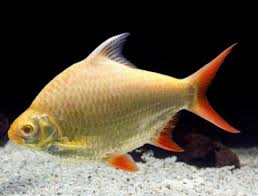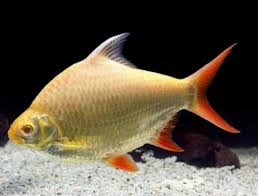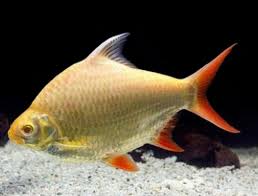Barb-Gold Tinfoil
Barb-Gold Tinfoil
check_circle Fast Shipping
check_circle Quality Products
check_circle Affordable Price
Reach out to us on ''available to order'' items via WhatsApp or email
Low stock: 3 left
Couldn't load pickup availability

Barb-Gold Tinfoil
package_2
Product Description
Product Description
The Golden Tinfoil Barb (Barbonymus schwanenfeldii) is a striking and popular species of freshwater fish known for its golden coloration and energetic nature. Here’s a detailed description and care guide for this beautiful fish:
Description
- Scientific Name: Barbonymus schwanenfeldii
- Common Names: Golden Tinfoil Barb, Golden Barb
-
Appearance:
- Coloration: The Golden Tinfoil Barb has a vibrant golden or yellowish body with red accents on its fins, especially on the dorsal, anal, and tail fins. It gives the fish a brilliant, eye-catching look.
- Size: It is a relatively large fish, capable of growing up to 12–14 inches (30–35 cm) in length, although it typically reaches 8–10 inches (20–25 cm) in home aquariums.
- Shape: It has a sleek, streamlined body with a slightly laterally compressed shape, ideal for fast swimming. The fish has large, forked fins that contribute to its graceful swimming abilities.
Care Requirements
-
Tank Size:
- Due to its size and active nature, the Golden Tinfoil Barb requires a large aquarium. A minimum tank size of 75 gallons (284 liters) is recommended, though larger tanks (100–125 gallons) are ideal, especially if you plan to keep multiple specimens.
- The tank should have plenty of space for swimming, as they are fast swimmers and need room to move freely.
-
Water Parameters:
- Temperature: 72–80°F (22–27°C). They prefer slightly warmer water but can tolerate a range of temperatures.
- pH: Slightly acidic to neutral (6.5–7.5). They can tolerate a pH range from 6.0–7.5.
- Hardness: Soft to moderately hard water (5–15 dGH) is preferred.
- Ammonia/Nitrite/Nitrate: Like all fish, they should be kept in a stable environment with 0 ppm of ammonia and nitrite, and nitrates below 20 ppm. Regular water changes (20–30% per week) are essential to maintain water quality.
-
Filtration:
- These fish produce a lot of waste, so a strong filtration system is necessary to keep the water clean and healthy. A canister filter or a high-flow hang-on-back filter should work well, and it's a good idea to have a filter with both mechanical and biological filtration.
-
Substrate and Decoration:
- The substrate can be fine gravel or sand, as long as it’s soft on their sensitive undersides. They do well with plenty of open swimming space, but adding some decorations like driftwood, rocks, and plants for hiding places is beneficial. Just ensure the decorations don’t block their swimming routes.
- Golden Tinfoil Barbs are not likely to uproot plants but can sometimes nibble on soft-leaved plants.
-
Lighting: They prefer moderately lit tanks, as they are not particularly sensitive to lighting but do best when the lighting isn’t too intense.
Diet
-
Omnivorous: Golden Tinfoil Barbs are opportunistic omnivores and require a well-balanced diet.
- Pellets and Flakes: High-quality sinking pellets or flakes designed for large omnivorous fish are a good base for their diet.
- Live/Frozen Foods: They enjoy live or frozen foods like bloodworms, brine shrimp, and daphnia, which should be fed occasionally to supplement their diet.
- Vegetables: They also benefit from plant matter, such as blanched spinach, zucchini, or peas.
- Feeding Schedule: Feed them once or twice a day in small portions. Make sure to remove any uneaten food to avoid water quality issues.
Behavior
-
Temperament: The Golden Tinfoil Barb is a peaceful and active fish. It is very social and should be kept in schools of at least 6–8 individuals to reduce stress and promote natural schooling behavior.
- They are generally not aggressive but may be a bit nippy toward smaller fish if they feel crowded or stressed, so it's important to house them with fish that are large enough to handle their energy and size.
- They are best kept in community tanks with other peaceful species that can keep up with their active swimming style.
-
Activity Level: These fish are very active and will spend a lot of time swimming throughout the aquarium. They thrive in environments where they have plenty of space and enrichment to explore. Their energetic nature makes them best suited for larger tanks with ample room for movement.
Tank Mates
- The Golden Tinfoil Barb is best kept with other medium-to-large peaceful fish that can tolerate their energetic nature and active swimming. Potential tankmates include:
- Larger tetras (e.g., rainbowfish, giant danios)
- Gouramis, cichlids (non-aggressive species), or peaceful catfish
- Avoid housing them with very small or slow-moving fish, such as neon tetras or bettas, as they may be intimidated or outcompeted for food.
Health and Common Issues
-
Health Issues:
- Fin rot: Like many barbs, Golden Tinfoil Barbs can develop fin rot if water quality deteriorates. Regular water changes and proper filtration can prevent this.
- Ich (white spot disease): Ich is a common issue, especially if the fish are stressed. Treatment with an anti-ich medication or adjusting the water temperature can help.
- Dropsey: This is a disease often caused by stress or poor water conditions, characterized by swelling or bloating. Prompt action and quarantine are necessary to prevent the spread to other fish.
- Stress: These fish are highly sensitive to changes in water conditions, so it’s important to keep the tank stable and perform regular water checks to avoid issues like stress-related diseases.
Breeding
- Breeding Golden Tinfoil Barbs in captivity is rare but possible with the right conditions. They are egg-layers and typically spawn during the rainy season in the wild. To encourage breeding:
- Water conditions: Slightly cooler water temperatures (around 72°F or 22°C) can stimulate breeding behavior.
- Tank setup: A separate breeding tank with fine-leaved plants or mesh for egg laying is recommended.
- After spawning, the adults should be removed from the tank to prevent them from eating the eggs.
- Fry are usually very small and will require very fine food, such as infusoria or newly hatched brine shrimp.
Summary
The Golden Tinfoil Barb is a stunning and lively fish that makes a beautiful addition to large, peaceful community aquariums. They require spacious tanks with plenty of swimming room, strong filtration, and a varied diet. Their golden coloration, combined with their active swimming style, makes them a highlight of any aquarium. When cared for properly, they can live for many years, often growing into large, graceful fish


